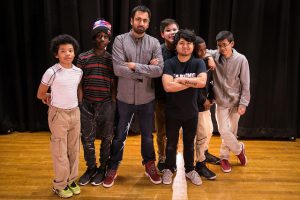Kal Penn Joins Harding in Academics and the Arts
Okay, who among us remembers what homeostasis means?
Maybe if we’d learned it the way 7th graders were in science class at Harding Middle School on Thursday afternoon…
To demonstrate how our bodies maintain internal equilibrium despite a wide variance of external conditions, teachers Randi Lines and Cara Lichty had their students calculate their resting heart rates by taking a pulse for six seconds and multiplying the result times ten. Then everybody got up and knocked out 25 jumping jacks before the rates were recalculated. Papers were blown off of desktops. Pencils rolled over the edge. And wait a second, who was that back in the corner of the room, working it right along with the rest of the class? None other than Kal Penn, noted motion picture/TV star and special envoy of the President’s Council on the Arts & Humanities (PCAH).
Penn is back in town for his third visit in connection with PCAH’s Turnaround Arts project. Harding is one of five DMPS schools in the Northside feeder pattern that comprise the district’s TA cohort. Four elementary schools – Cattell, Findley, Madison and Oak Park – are the others. Turnaround Arts emphasizes integration of artistic elements throughout a curriculum as a catalyst for boosting student achievement in all areas.
Okay, so jumping jacks aren’t exactly an art form. But movement/dance is and there was plenty of that woven into various demonstrations of the characteristics of living things, the current unit in Room 246.
Human bar graphs were formed to measure results on questions like whether or not fire is alive (a scientist will tell you it’s not but an artist might beg to differ).
Cassie Kendzora is Harding’s Arts Integration Specialist and she was right in the thick of things, too. She regularly collaborates with Harding teachers on strategies for incorporating TA principles into their lesson-planning, not just when Penn is in town. Thursday she led the class in a loosen-up routine called the “brain dance” that set the stage for the day’s scientific content.
“Alright, everybody, hands in the air!” she shouted. “Now scrunch up tight around your core…tickle your face…feel the tingle?”
So the blood was really flowing by the time they got to the heart rate exercise as an example of a homeostatic regulator.
“This class is a real mix of students along the spectrum,” Kendzora pointed out. “Some of them have IEP’s (Individualized Education Plans), some of them are ELL (English Language Learner). One of the great things about arts integration is that movement, or body language, is universal.”
Drama, visual art and music, too, cut through differences that would otherwise pose obstacles to effective instruction.”
There were three minutes left at the end of the class period, just enough for a brief Q&A with the celebrity guest before he was off to work with the Harding Breakerz on a TA video. One student mentioned having seen Penn recently on a TV show called Superhuman, a reality show he hosts that focuses on seemingly ordinary people with extraordinary abilities, not so different from what he’s doing in Des Moines. Another kid wanted to know how and why Penn got into acting. Perfect – right on cue he stressed that after he discovered it was something he enjoyed and had a talent for (at a public school with a robust arts program) he realized that going out on auditions would require the ability to read scripts and such at a much faster pace than he was accustomed to reading. So he had to buckle down in order to pursue his artsy dream.
In other words, he had to self-regulate to maintain stability while adjusting to conditions that were optimal for his survival…a classic case of homeostasis.





